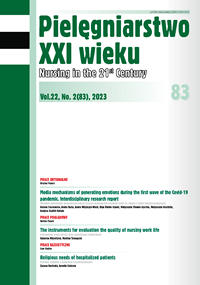Couvade Syndrome among partners of women with physiological and complicated pregnancy
DOI:
https://doi.org/10.2478/pielxxiw-2023-0011Keywords:
couvade syndrome, complicated pregnancy, pregnancyAbstract
COUVADE SYNDROME AMONG PARTNERS OF WOMEN WITH PHYSIOLOGICAL AND COMPLICATED PREGNANCY
Aim. To assess the prevalence of couvade syndrome and analyze the factors determining the occurrence of this syndrome in the partners of pregnant women.
Material and method. The research material was collected by a diagnostic survey, using an author’s survey questionnaire.
Results. Couvade Syndrome occurs in 94.3% of partners of women with complicated pregnancies. Among the most common somatic symptoms there are: back pain (56.2%), headaches (53.3%), appetite changes (48.6%), indigestion (34.3%) and abdominal pain of unknown origin (31.4%), while mental ones include: sleep disturbances (37.1%), irritability (34.3%), tension (32.4%), regardless of the course of partner’s pregnancy. Men, who were married, were more likely to have Couvade symptoms than those in an informal relationship, regardless of the course of partner’s pregnancy (p=0.02). Respondents without Couvade Syndrome were more likely to have low levels of involvement in their partner’s current pregnancy than those with symptoms, regardless of the course of this pregnancy (p=0.03). Men with symptoms of the syndrome were more likely to be less involved in their responsibilities at work than those without symptoms, regardless of the course of partner’s pregnancy (p=0.0006).
Conclusions. The majority (94.3%) of partners of women with complicated pregnancies have a Couvade Syndrome. The most common somatic symptoms include back pain, headaches, appetite changes, indigestion and abdominal pain of unknown origin, while the mental ones: sleep disturbances, irritability, tension, anxiety and nervousness. Married men are more likely to have Couvade Syndrome than those in an informal relationship. Low levels of involvement in the current pregnancy are shown by men who do not have the syndrome. Men, who have the Couvade Syndrome, are less involved in their work responsibilities.
References
1. Enoch D, Ball H. The Couvade Syndrome. [w:] Enoch D, Ball H red. Uncommon Psychiatric Syndromes. London: Arnold; 2001, s.95-110.
2. Ganapathy T. Couvade syndrome among 1st time expectant fathers. Muller J. Med. Sci. Res. 2014; 5(1): 43-47.
3. Johansson M, Edwardsson C, Hildingsson I. The “Pregnant Man”- expecting fathers experience pregnancy- related changes: a longitudinal study with a mixed method approach. J. Mens Health. 2015; 11(6): 8-18.
4. Ariani TA. Couvade Syndrome and Health Status of The First Trimester of Primigravida. Adv. Health Sci. Res. 2017; 2: 105-113.
5. Kiełbratowska B, Kaźmierczak M, Michałek J i wsp. Couvade syndrome perceived by medical staff and partners of expectant fathers. Ginekol. Pol. 2015; 3(37): 42-48.
6. Iwanowicz-Palus G, Stobnicka D, Myszewska A, i wsp. Nowe techniki porodowe. [w:] Iwanowicz-Palus G red. Alternatywne metody opieki okołoporodowej. Warszawa: Wyd. Lek. PZWL; 2012, s.13-86.
7. Akoijam MD, Maisnam PC. Couvade syndrome. Int. J. Nurs. Educ. Res. 2015; 3(3): 109-111.
8. Kaźmierczak M, Kiełbratowska B, Pastwa-Wojciechowska B, et al. Couvade Syndrome among Polish expectant fathers. Med. Sci. Monit. 2013; 19: 132-138.
9. Sioma-Markowska U, Zyg M, Kiełbratowska B. Psychosomatic symptoms of the Couvade syndrome in Finnish and Polish expectant fathers. Ginekol. Pol. 2018; 89(1): 35-39.
10. Głażewska E. Kuwada - historia i zasięg występowania. [w:] Głażewska E red. Kuwada. Egzotyczny zwyczaj w nowej odsłonie. Lublin: Wyd. UMCS; 2014, s.49-79.
11. Devi AM, Chanu MP. Couvade syndrome. Int J Nurs Educ Res. 2015; 3(3): 109-111.
12. Lipkin M, Lamb G. The couvade syndrome: an epidemiologic study. Ann Intern Med. 1982; 96(4): 509-511.
13. Brennan A, Marshall-Lucette S, Ayers S, et al. A qualitative exploration of the Couvade syndrome in expectant fathers. J Reprod Infant Psychol. 2007; 25(1): 18-39.
14. Mrayan L, Abujilban S, Abuidhail J, et al. Couvade syndrome among Jordanian expectant fathers. Am. J. Mens Health. 2018; 13(1): 1-9.
Downloads
Published
Issue
Section
License
Copyright (c) 2023 Authors

This work is licensed under a Creative Commons Attribution 4.0 International License.




